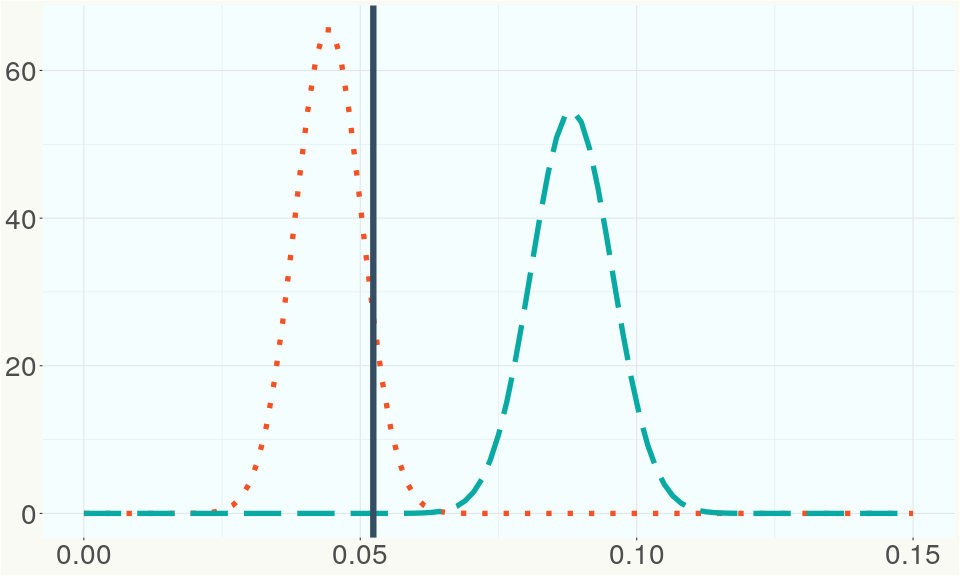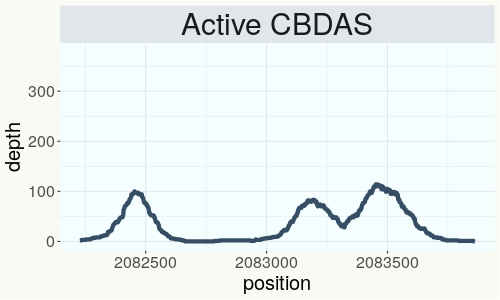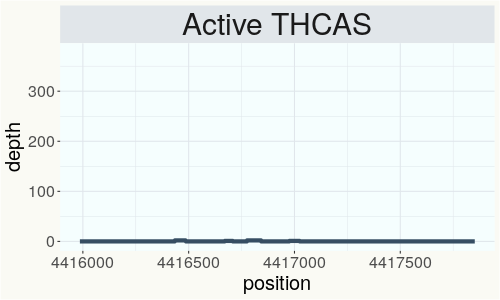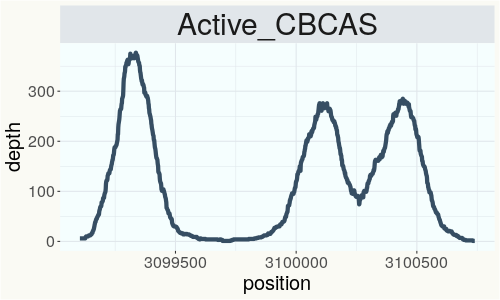Cherry Blossom
RSP 11332
Grower: Yabba Cannaba
General Information
- Sample Name
- CI4
- Accession Date
- October 17, 2019
- Reported Plant Sex
- Female
- Report Type
- StrainSEEK v2 3.2Mb
- DNA Extracted From
- Stem
The strain rarity visualization shows how distant the strain is from the other cultivars in the Kannapedia database. The y-axis represents genetic distance, getting farther as you go up. The width of the visualization at any position along the y-axis shows how many strains there are in the database at that genetic distance. So, a common strain will have a more bottom-heavy shape, while uncommon and rare cultivars will have a visualization that is generally shifted towards the top.
Chemical Information
Cannabinoid and terpenoid information provided by the grower.
Cannabinoids
No information provided.
Terpenoids
No information provided.
Genetic Information
- Plant Type
- Type III
File Downloads
The bell curve in the heterozygosity visualization shows the distribution of heterozygosity levels for cannabis cultivars in the Kannapedia database. The green line shows where this particular strain fits within the distribution. Heterozygosity is associated with heterosis (aka hybrid vigor) but also leads to the production of more variable offspring. When plants have two genetically different parents, heterozygosity levels will be higher than if it has been inbred or backcrossed repeatedly.
The ratio of reads mapped to Y-contigs to reads mapped to the whole Cannabis genome (Y-ratios) has been demonstrated to be strongly correlated with plant sex typing. This plot shows the distribution of Y-ratios for all samples in our database which were sequenced with the same method (panel or WGS) as this sample and where this sample falls in the distribution.

This chart represents the Illumina sequence coverage over the Bt/Bd allele. These are the three regions in the cannabis genome that impact THCA, CBDA, CBGA production. Coverage over the Active CBDAS gene is highly correlated with Type II and Type III plants as described by Etienne de Meijer. Coverage over the THCA gene is highly correlated with Type I and Type II plants but is anti-correlated with Type III plants. Type I plants require coverage over the inactive CBDA loci and no coverage over the Active CBDA gene. Lack of coverage over the Active CBDA and Active THCA allele are presumed to be Type IV plants (CBGA dominant). While deletions of entire THCAS and CBDAS genes are the most common Bt:Bd alleles observed, it is possible to have plants with these genes where functional expression of the enzyme is disrupted by deactivating point mutations (Kojoma et al. 2006).



This chart represents the Illumina sequence coverage over the CBCA synthase gene.

Variants (THCAS, CBDAS, and CBCAS)
Variants (Select Genes of Interest)
| GPPs1 |
c.845_848del |
p.Glu282fs | frameshift variant | high | contig676 | 169629 | TGAAA/T |
|
| PKSG-2a | c.67T>A | p.Phe23Ile | missense variant | moderate | contig700 | 1945567 | A/T | |
| PKSG-2a | c.31A>T | p.Thr11Ser | missense variant | moderate | contig700 | 1945603 | T/A | |
| PKSG-2b | c.1132C>G | p.Leu378Val | missense variant | moderate | contig700 | 1950506 | G/C |
|
| PKSG-2b | c.1117A>G | p.Ile373Val | missense variant | moderate | contig700 | 1950521 | T/C | |
| PKSG-2b | c.31A>T | p.Thr11Ser | missense variant | moderate | contig700 | 1951851 | T/A | |
| PKSG-4b | c.496A>G | p.Lys166Glu | missense variant | moderate | contig700 | 2721177 | T/C | |
| PKSG-4b | c.489delT | p.Phe163fs | frameshift variant | high | contig700 | 2721183 | CA/C | |
| PKSG-4b | c.485A>G | p.Lys162Arg | missense variant | moderate | contig700 | 2721188 | T/C | |
| PKSG-4b | c.431T>G | p.Val144Gly | missense variant | moderate | contig700 | 2721242 | A/C | |
| PKSG-4b | c.419A>G | p.Asp140Gly | missense variant | moderate | contig700 | 2721254 | T/C | |
| PKSG-4b |
c.352_355del |
p.Thr118fs | frameshift variant | high | contig700 | 2721317 | CCTGT/C |
|
| PKSG-4b | c.323A>G | p.Glu108Gly | missense variant | moderate | contig700 | 2721350 | T/C |
|
| DXR-2 | c.1319T>C | p.Ile440Thr | missense variant | moderate | contig380 | 285250 | A/G |
|
| HDS-2 |
c.82_93delGT |
p.Val28_Thr3 |
conservative inframe deletion | moderate | contig95 | 1989748 |
CGTAACCGGAAC |
|
| HDS-2 | c.127T>G | p.Ser43Ala | missense variant | moderate | contig95 | 1989794 | T/G |
|
Nearest genetic relatives (All Samples)
- 0.083 Unknown--Cherry Wine---005- (RSP11272)
- 0.117 Cherry Blossom (RSP11320)
- 0.137 Cherry Blossom (RSP11310)
- 0.144 Cherry Blossom (RSP11304)
- 0.158 Electra (RSP11366)
- 0.160 Cherry Blossom (RSP11300)
- 0.161 Lift (RSP11378)
- 0.173 Cherry Blossom (RSP11325)
- 0.174 13 Cherries (RSP11442)
- 0.177 Cherry Blossom (RSP11308)
- 0.179 Cherry Blossom (RSP11299)
- 0.180 Cherry Blossom (RSP11328)
- 0.181 Cherry Blossom (RSP11335)
- 0.188 Unknown--Cherry Wine---003- (RSP11270)
- 0.190 Cherry Blossom (RSP11309)
- 0.194 Cherry Blossom (RSP11313)
- 0.195 Cherry Wine (RSP11305)
- 0.195 Cherry Wine (RSP11307)
- 0.195 Unknown--Cherry Wine---002- (RSP11269)
- 0.198 Suver Haze (RSP11364)
Most genetically distant strains (All Samples)
- 0.459 JL yellow (RSP11075)
- 0.451 Kush Hemp E1 (RSP11128)
- 0.449 BagSeed (RSP12501)
- 0.446 JL 4th Gen 2 (RSP11194)
- 0.445 JL 3rd Gen Mother (RSP11214)
- 0.442 Abacus (RSP11266)
- 0.441 JL 4th Gen 5 (RSP11199)
- 0.440 R1in136 (SRR14708226)
- 0.439 R3in134 (SRR14708218)
- 0.437 VIR 223 - Bernburgskaya Odnodomnaya - bm (SRR14708217)
- 0.437 RKM-2018-002 (RSP11093)
- 0.436 R1in136 (SRR14708237)
- 0.434 R3in134 (SRR14708220)
- 0.432 JL 3rd Gen Father (RSP11196)
- 0.432 Danny Noonan (RSP11070)
- 0.432 Fatso (RSP11741)
- 0.431 80E (RSP11213)
- 0.430 Ruderalis Indica (SRR14708267)
- 0.430 R1in136 (SRR14708227)
- 0.429 XBL1 (SRR14708207)
Nearest genetic relative in Phylos dataset
- Overlapping SNPs:
- 63
- Concordance:
- 42
Nearest genetic relative in Lynch dataset
- Overlapping SNPs:
- 4
- Concordance:
- 4
Blockchain Registration Information
- Transaction ID
-
609ae69214ba6522
447020eff3b65eac 5976bd63d00f00bf 0501aef85c61aa06 - Stamping Certificate
- Download PDF (854.7 KB)
- SHASUM Hash
-
b1498826b73874e1c381577887a64d06 0f9249109f148411 629023b42431130f